MENU
The Electronic Scholarly Publishing Project: Providing access to classic scientific papers and other scholarly materials, since 1993. More About: ESP | OUR CONTENT | THIS WEBSITE | WHAT'S NEW | WHAT'S HOT
Comparative Timelines
The ESP Timeline (one of the site's most popular features) has been completely updated to allow the user to select (using the timeline controls above each column) different topics for the left and right sides of the display.
Select:
New Left Column
New Left Column
Dates
Decade
New Right Column
New Right Column
Based on studies of Y chromosomes, Peter Underhill publishes his finding that all modern humans share a common ancestor, bolstering the 1987 announcement from Cann and Wilson. This suggests a "bottleneck" event (population crash) among human ancestors living in Africa roughly 150,000 years ago.
Sally McBearty and Alison Brooks publish "The Revolution that Wasn't" challenging the long-held notion of a "big bang" in human intellectual evolution approximately 40,000 years ago. Instead, they cite evidence for earlier appearances of modern behavior.
A research team led by Paul Sereno discovers Rugops primus ("first wrinkle face") in the Sahara. This dinosaur's resemblance to South American fossils suggests that Africa separated from the ancient landmass of Gondwana more recently than previously thought.
Phil Currie publishes a paper suggesting that T. rex was a social animal that hunted in packs.
2000
(no entry for this year)
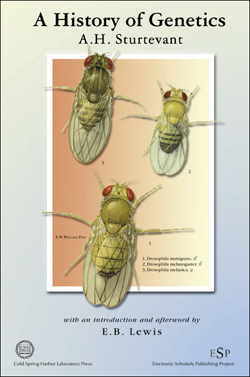 Alfred Sturtevant's A History of Genetics is republished jointly by the Electronic Scholarly Publishing Project and the Cold Spring Harbor Laboratory Press. Sturtevant provides an insider's perspective (he created the FIRST GENETIC MAP ) to this first-rate summary of the foundations of classical genetics.
Alfred Sturtevant's A History of Genetics is republished jointly by the Electronic Scholarly Publishing Project and the Cold Spring Harbor Laboratory Press. Sturtevant provides an insider's perspective (he created the FIRST GENETIC MAP ) to this first-rate summary of the foundations of classical genetics.
CLICK TO BUY THIS BOOK
The International Human Genome Sequencing Consortium (Human Genome Project) publishes the initial sequence and analysis of the human genome in Nature Magazine. Celera Genomics simultaneously publishes a draft human genome sequence in Science Magazine.
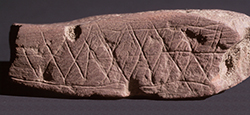 Chris Henshilwood and collaborators discover and describe 77,000-year-old artwork: stones carved with lines and triangles, from Blombos Cave on the Southern Cape coast of Africa. Three years later, Henshilwood and collaborators will describe more Blombos artifacts: tiny snail shells that were apparently pierced and worn as jewelry about 76,000 years ago. A few years after that, another research team will describe similar shell beads, at least 100,000 years old, in Israel and Algeria.
Chris Henshilwood and collaborators discover and describe 77,000-year-old artwork: stones carved with lines and triangles, from Blombos Cave on the Southern Cape coast of Africa. Three years later, Henshilwood and collaborators will describe more Blombos artifacts: tiny snail shells that were apparently pierced and worn as jewelry about 76,000 years ago. A few years after that, another research team will describe similar shell beads, at least 100,000 years old, in Israel and Algeria.
Joshua Smith and collaborators publish a description of a giant sauropod from Egypt, possibly the largest Cretaceous sauropod yet discovered. It is considered a possible food source for three large carnivorous dinosaur species discovered decades earlier by Ernst Stromer.
Luann Becker and collaborators publish a paper describing carbon fullerenes (buckyballs) at the Permo-Triassic boundary in China, Japan and Hungary. Because they can occur in meteorites, the fullerenes are cited as evidence of a meteorite impact at the end of the Permian. Other scientists will have difficulty reproducing their results, however, and the researchers' claim will remain controversial.
Odin and Néraudeau publish a description of a Neanderthal flint tool found in southwestern France with a fossil sea urchin on one side.
2001
(no entry for this year)
David Lordkipanidze and collaborators excavate a 1.77-million-year-old Homo erectus skull of a "toothless old man" in Dmanisi. New bone growth after the loss of his teeth suggests that he was cared for by others, the oldest evidence yet found of care for the sick in fossil hominids.
Michel Brunet and collaborators publish a description of Sahelanthropus tchadensis, a hominid fossil from western central Africa. Suspected to be 6 to 7 million years old, it is possibly the oldest hominid fossil yet found. Its location, in Chad, is expected to spur hominid fossil hunting west of Africa's Rift Valley.
2002
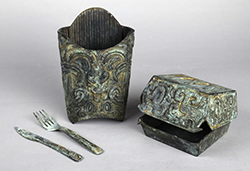 Sculpture by Zhang Hongtu: Mai Dang Lao (McDonald's), a set of readily identifiable McDonald's hamburger box, french-fry container, fork, and knife are cast in bronze and adorned with traditional Chinese designs. The artist has transformed ubiquitous consumer items into what at first glance appear to be Shang dynasty artifacts. Hilarious.
Sculpture by Zhang Hongtu: Mai Dang Lao (McDonald's), a set of readily identifiable McDonald's hamburger box, french-fry container, fork, and knife are cast in bronze and adorned with traditional Chinese designs. The artist has transformed ubiquitous consumer items into what at first glance appear to be Shang dynasty artifacts. Hilarious.
M.R. Sánchez-Villagra, O. Aguilera and I. Horovitz publish a description of Phoberomys, a fossil rodent from Venezuela the size of a buffalo.
Paleontologists in Germany identify the world's oldest pantry: an underground burrow system probably dug by an extinct species of ground squirrel or hamster. Estimated at 17 million years old, the food stash is stuffed with more than 1,800 fossilized nuts.
Paleontologists led by John Horner find a T. rex fossil that will later yield evidence of blood vessels and blood cells. The fossil will also prove to be an egg-laying female.
Two separate teams, digging 2,000 miles apart, find two new Antarctic dinosaurs in the same week. One appears to be a Jurassic sauropod, the other a Cretaceous theropod.
2003
(no entry for this year)
Peter Brown, Mike Morwood and collaborators announce the find of a 1-meter- tall hominid skeleton on the Indonesian island of Flores. Found near the remains of giant lizards and pygmy elephants, the new species is formally named Homo floresiensis and nicknamed the "hobbit." Though some suspect it's a kind of malformed, small-brained midget, this interpretation will be answered by braincase scans, wrist bones too primitive to be Homo sapiens, and the announcement of several more individuals of the same species. Later studies will suggest direct ancestry from Homo erectus, although another study will argue the remains really indicate Down syndrome. The species is initially given an estimated age as young as 11,000 years, but later research will indicate an age of at least 50,000 years.
A 70-million-year-old mammal jaw is found in Pui, Romania, some 100 miles from Vlad Dracula's castle. Eleven years later, the animal will be formally named Barbatodon transylvanicus by scientists who note that strengthening iron, not blood drinking, gives the teeth their bright red color.
D. Néraudeau describes deposits in western France revealing hundreds of Acheulian and Mousterian tools, 12 of them bearing fossils.
Heather Wilson and Lyall Anderson publish a paper describing the oldest land animal fossil yet discovered: Pneumodesmus newmani, a 428-million- year-old, centimeter-long millipede found by amateur fossil hunter Mike Newman.
M.-Y. Zhu and collaborators publish a description of munched trilobite parts inside another arthropod, confirming earlier suspicions that other animals snacked on the little water bugs.
Naama Goren-Inbar and her team announce the discovery of controlled fire use by hominids at a 790,000-year-old site in Israel, pushing the earliest known use of fire back 300,000 years from previous estimates.
Qingjin Meng and collaborators publish a description of an adult Psittacosaurus dinosaur associated with 34 juveniles, apparent evidence of parental care.
The British Museum begins an excavation project at Happisburgh in Norfolk. Over the next six years, researchers will uncover artifacts pushing back the earliest evidence of human activity at such a high latitude — 45 degrees — to perhaps as much as 950,000 years ago.
Using CT scans on femurs of the early hominid Orrorin tugenensis discovered in Kenya, Galik and collaborators push back the development of bipedalism in hominids to 6 million years ago (2 million years earlier than in Australopithecus anamensis).
X. Wang and Z. Zhou publish a description of the first known pterosaur egg containing an exquisitely preserved embryo. Though the egg is slightly smaller than the average chicken egg, the embryo sports a 27-centimeter wingspan. Several months later, Z. Zhou and F. Zhang publish a description of a Cretaceous bird embryo, the first found with feathers.
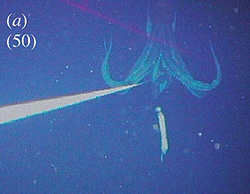 A team of Japanese researchers take the first photograph ever of a giant squid in the wild. Unfortunately, they rip off one of the poor creature's tentacles in the process.
A team of Japanese researchers take the first photograph ever of a giant squid in the wild. Unfortunately, they rip off one of the poor creature's tentacles in the process.
The International Union of Geological Sciences adds a new period to the Earth's geologic timescale: the Ediacaran. Ranging from approximately 600 million years ago to 542 million years ago, it begins after the last Snowball Earth ice age and precedes the Cambrian. It's the first new geologic period designated in 120 years.
2004
(no entry for this year)
M.A. Whyte announces the discovery of a 330-million-year-old trackway of a 5-foot-long, six-legged water scorpion (eurypterid) that could walk on land while the first tetrapods tried to do the same thing. Two years later, Simon Braddy, Markus Poschmann and collaborators will announce the find of fossil claw from an 8-foot eurypterid.
Yaoming Hu, Jin Meng, Yuanqing Wang and Chuankui Li publish a description of two large carnivorous mammals from the Cretaceous, one of which appears to have the remains of a diminutive dinosaur in its stomach. These fossils overturn long-held notions that Mesozoic mammals were all rat-sized plebeians scurrying around dinosaur feet.
Yohannes Haile-Selassie and colleagues announce the find of a nearly 4- million-year-old hominid from Ethiopia, possibly the remains of Australopithecus anamensis.
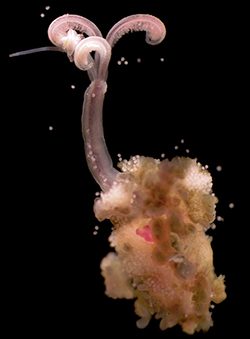 Adrian Glover and Thomas Dahlgren announce the discovery of a new species of marine worm, discovered off the Swedish coast, that lives on whale bones on the sea floor. They name the species Osedax mucofloris.
Adrian Glover and Thomas Dahlgren announce the discovery of a new species of marine worm, discovered off the Swedish coast, that lives on whale bones on the sea floor. They name the species Osedax mucofloris.
2005
(no entry for this year)
Jean Moliner, Gerhard Ries, Cyril Zipfel and Barbara Hohn publish their findings on stressed plants that not only mutate at a greater rate, but also pass an increased mutation tendency to their offspring.
Jin Meng and collaborators describe a Mesozoic gliding mammal that pushes back the origin of mammalian flight by 70 million years, and suggests mammals maybe dabbled in flight earlier than birds.
Qiang Li and colleagues describe Castorocauda lutrasimilis, a Jurassic mammal that looked something like a mix between a beaver, otter, and platypus. Their discovery pushes back mammalian adaptation to an aquatic lifestyle by more than 100 million years.
The Research Council of Norway announces that oil drillers have struck a piece of dinosaur bone off the country's coast. At 1.4 miles below the North Sea, the bone fragment obtains the status of the world's deepest dinosaur.
Zeresenay Alemseged and collaborators publish a description of a 3.3- million-year-old partial skeleton from a juvenile Australopithecus afarensis from Ethiopia. The remains indicate that the australopithecene toddler walked upright and climbed trees.
Paleontologist Neil Clark suggests that some Loch Ness "sightings" may have been inspired by partial glimpses of traveling circus elephants taking dips in the lake.
2006
(no entry for this year)
Divers find a submerged cavern in the Yucatán and name it Hoyo Negro. The cavern contains the remains of a teenage female who likely died between 12,000 and 13,000 years ago.
Fred Spoor, Meave Leakey and collaborators describe remains of Homo habilis and Homo erectus from the same rock layer a short distance apart. The finds suggest that the two species coexisted in the same area for up to 500,000 years, and that H. erectus probably did not descend from H. habilis as previously thought.
John Kappelman and collaborators announce the find of a 500,000-year-old hominid skull from Turkey showing signs of tuberculosis. The researchers argue that condition could be induced by a Vitamin D deficiency resulting from a dark-skinned individual migrating to an area with less sunlight.
Kate Trinajstic and collaborators announce the discovery of 380-million- year-old Australian fossil fish sporting fossilized muscle.
Xing Xu and collaborators describe Gigantoraptor erlianensis, a 25- foot-long, 3,000-pound, bird-like dinosaur from Inner Mongolia. The find runs counter to earlier assumptions that dinosaurs necessarily got smaller as they acquired more features resembling those of birds.
2007
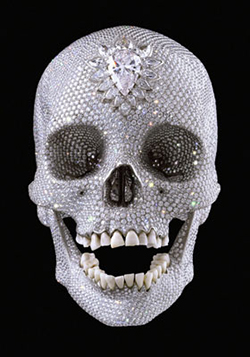 Sculpture by Damien Hirst: For the Love of God consists of a platinum cast of an 18th-century human skull encrusted with 8,601 flawless diamonds, including a pear-shaped pink diamond located in the forehead that is known as the Skull Star Diamond. The skull's teeth are actual human teeth, and were purchased by Hirst in London. The artwork is a Memento mori, or reminder of the mortality of the viewer. In 2007, art historian Rudi Fuchs, observed: 'The skull is out of this world, celestial almost. It proclaims victory over decay. At the same time it represents death as something infinitely more relentless. Compared to the tearful sadness of a vanitas scene, the diamond skull is glory itself.' Costing 14 million to produce, the work was placed on its inaugural display at the White Cube gallery in London in an exhibition Beyond belief with an asking price of 50 million. This would have been the highest price ever paid for a single work by a living artist. The base for the work is a human skull bought in a shop in Islington. It is thought to be that of a 35-year-old European who lived between 1720 and 1810. The work's title was supposedly inspired by Hirst's mother, who once asked, "For the love of God, what are you going to do next? Hirst said that the work was sold on 30 August 2007, for 50 million, to an anonymous consortium. Christina Ruiz, editor of The Art Newspaper, claims that Hirst had failed to find a buyer and had been trying to offload the skull for 38 million. Immediately after these allegations were made, Hirst claimed he had sold it for the full asking price, in cash, leaving no paper trail. The consortium that bought the piece included Hirst himself.
Sculpture by Damien Hirst: For the Love of God consists of a platinum cast of an 18th-century human skull encrusted with 8,601 flawless diamonds, including a pear-shaped pink diamond located in the forehead that is known as the Skull Star Diamond. The skull's teeth are actual human teeth, and were purchased by Hirst in London. The artwork is a Memento mori, or reminder of the mortality of the viewer. In 2007, art historian Rudi Fuchs, observed: 'The skull is out of this world, celestial almost. It proclaims victory over decay. At the same time it represents death as something infinitely more relentless. Compared to the tearful sadness of a vanitas scene, the diamond skull is glory itself.' Costing 14 million to produce, the work was placed on its inaugural display at the White Cube gallery in London in an exhibition Beyond belief with an asking price of 50 million. This would have been the highest price ever paid for a single work by a living artist. The base for the work is a human skull bought in a shop in Islington. It is thought to be that of a 35-year-old European who lived between 1720 and 1810. The work's title was supposedly inspired by Hirst's mother, who once asked, "For the love of God, what are you going to do next? Hirst said that the work was sold on 30 August 2007, for 50 million, to an anonymous consortium. Christina Ruiz, editor of The Art Newspaper, claims that Hirst had failed to find a buyer and had been trying to offload the skull for 38 million. Immediately after these allegations were made, Hirst claimed he had sold it for the full asking price, in cash, leaving no paper trail. The consortium that bought the piece included Hirst himself.
After studying grunting fish, Andrew Bass and colleagues report that the part of the brain controlling volcalization is extremely primitive, and propose that vertebrates evolved the ability to communicate through sound some 400 million years ago.
Based on studies of fossils and extant carnivores, Chris Carbone and collaborators suggest that sabertooth cats were sociable animals that hunted in packs.
Chinese and Brazilian researchers describe a sparrow-sized pterosaur from northeastern China. Although a juvenile, the pterosaur is no hatchling, and it's more mature than any of the smaller pterosaurs so far found. The researchers name the species Nemicolopterus crypticus meaning "hidden flying forest dweller."
Susan Evans, Marc Jones and David Krause describe a bowling-ball-sized fossil frog from Madagascar. Because the Cretaceous creature's closest living relative is in South America, the scientists posit a land link connecting South America, Antarctica and Madagascar. The frog is named Beelzebufo ampinga, translated loosely as "armored devil toad" or more loosely as "fossil frog from hell."
2008
(no entry for this year)
Gabriele Gentile and colleagues describe a previously overlooked pink iguana, referred to as "rosada," on the Galápagos Islands. The pink lizard species may represent the earliest divergence of land animals on the island chain that Charles Darwin made famous.
Anthony Martin and colleagues announce the discovery of three 106-million- year-old burrows in Australia that they identify as dinosaur burrows, perhaps used by the ancient reptiles to keep warm during the winter when Australia was closer to the South Pole.
Australian paleontologists announce the find of Zac, a plant-munching sauropod, on a sheep farm — the same sheep farm where paleontologists discovered Cooper, an armor-plated titanosaur, in 2004.
Chris Henshilwood and collaborators describe 13 engraved ochre artifacts from South Africa's Blombos Cave, some dating back 100,000 years. This discovery supplements earlier finds pushing back the advent of human artwork.
Erik Seiffert and coauthors argue that "missing link" Darwinius masillae described earlier in the year is not an ancestor of modern apes and monkeys but instead of modern lemurs and lorises.
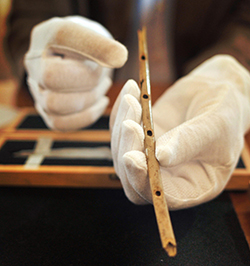 Nicholas Conard and collaborators describe 35,000-year-old flutes, one nearly complete flute carved from bird bone, and flute fragments carved from ivory, discovered in Hohle Fels Cave in Ulm, Germany.
Nicholas Conard and collaborators describe 35,000-year-old flutes, one nearly complete flute carved from bird bone, and flute fragments carved from ivory, discovered in Hohle Fels Cave in Ulm, Germany.
2009
(no entry for this year)
ESP Quick Facts
ESP Origins
In the early 1990's, Robert Robbins was a faculty member at Johns Hopkins, where he directed the informatics core of GDB — the human gene-mapping database of the international human genome project. To share papers with colleagues around the world, he set up a small paper-sharing section on his personal web page. This small project evolved into The Electronic Scholarly Publishing Project.
ESP Support
In 1995, Robbins became the VP/IT of the Fred Hutchinson Cancer Research Center in Seattle, WA. Soon after arriving in Seattle, Robbins secured funding, through the ELSI component of the US Human Genome Project, to create the original ESP.ORG web site, with the formal goal of providing free, world-wide access to the literature of classical genetics.
ESP Rationale
Although the methods of molecular biology can seem almost magical to the uninitiated, the original techniques of classical genetics are readily appreciated by one and all: cross individuals that differ in some inherited trait, collect all of the progeny, score their attributes, and propose mechanisms to explain the patterns of inheritance observed.
ESP Goal
In reading the early works of classical genetics, one is drawn, almost inexorably, into ever more complex models, until molecular explanations begin to seem both necessary and natural. At that point, the tools for understanding genome research are at hand. Assisting readers reach this point was the original goal of The Electronic Scholarly Publishing Project.
ESP Usage
Usage of the site grew rapidly and has remained high. Faculty began to use the site for their assigned readings. Other on-line publishers, ranging from The New York Times to Nature referenced ESP materials in their own publications. Nobel laureates (e.g., Joshua Lederberg) regularly used the site and even wrote to suggest changes and improvements.
ESP Content
When the site began, no journals were making their early content available in digital format. As a result, ESP was obliged to digitize classic literature before it could be made available. For many important papers — such as Mendel's original paper or the first genetic map — ESP had to produce entirely new typeset versions of the works, if they were to be available in a high-quality format.
ESP Help
Early support from the DOE component of the Human Genome Project was critically important for getting the ESP project on a firm foundation. Since that funding ended (nearly 20 years ago), the project has been operated as a purely volunteer effort. Anyone wishing to assist in these efforts should send an email to Robbins.
ESP Plans
With the development of methods for adding typeset side notes to PDF files, the ESP project now plans to add annotated versions of some classical papers to its holdings. We also plan to add new reference and pedagogical material. We have already started providing regularly updated, comprehensive bibliographies to the ESP.ORG site.
ESP Picks from Around the Web (updated 06 MAR 2017 )
Old Science

Weird Science

Treating Disease with Fecal Transplantation
Fossils of miniature humans (hobbits) discovered in Indonesia

Dinosaur tail, complete with feathers, found preserved in amber.
Astronomy

Mysterious fast radio burst (FRB) detected in the distant universe.